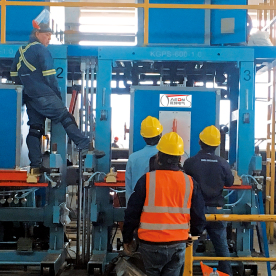In the ever-evolving landscape of manufacturing, the demand for precision and efficiency has never been greater. Industries ranging from woodwork to metal fabrication are consistently seeking innovative solutions to enhance productivity while maintaining the highest quality standards. One such solution that has gained traction in recent years is the Precision Flying Saw Machine. This advanced technology offers manufacturers a unique approach to cutting materials with remarkable accuracy and speed, thus redefining the cutting processes and strategies employed across various sectors.
What is a Precision Flying Saw Machine?
A Precision Flying Saw Machine is a specialized cutting tool designed to perform high-speed, precision cutting of various materials including metals, plastics, composites, and wood. Unlike traditional saws that operate through sequential movements, flying saws utilize a unique mechanism that allows the saw blade to remain in motion while simultaneously cutting through the material. This continuous motion reduces cycle times and enhances the efficiency of the cutting process, making it particularly advantageous for high-volume production environments.
Key Features and Advantages
1. **High-Speed Operation**
One of the standout features of Precision Flying Saw Machines is their ability to operate at high speeds. This capability allows manufacturers to significantly increase production rates without compromising the quality of the finished product. The continuous motion of the saw minimizes downtime typically associated with start-stop cutting processes, ensuring that operations remain uninterrupted.

Revolutionizing Manufacturing Processes with Precision Flying Saw Machines: A Comprehensive Overview of Their Benefits and Applications
2. **Exceptional Accuracy**
Precision is paramount in manufacturing, and flying saw technology delivers on this front. These machines are engineered to make precise cuts, resulting in minimal material wastage and optimal material utilization. The accuracy achieved through flying saw machines helps in maintaining consistent product dimensions, which is essential for high-quality outputs, especially in industries that require intricate designs and tight tolerances.
3. **Versatility**

Revolutionizing Manufacturing Processes with Precision Flying Saw Machines: A Comprehensive Overview of Their Benefits and Applications

Revolutionizing Manufacturing Processes with Precision Flying Saw Machines: A Comprehensive Overview of Their Benefits and Applications
Precision Flying Saw Machines are versatile and can be adapted to cut a wide range of materials. Whether it’s cutting through metals, plastics, or lumber, these machines can handle various thicknesses and densities, making them suitable for a diverse array of industries, including construction, automotive, aerospace, and furniture manufacturing. Their adaptability makes them a valuable asset in a manufacturing setup where different products are produced.
4. **Minimal Maintenance**
The design of Precision Flying Saw Machines generally requires less maintenance compared to traditional cutting equipment. This reduction in maintenance needs translates into lower downtime and operational costs. Moreover, the longevity of the machine due to less wear and tear results in an overall higher return on investment for manufacturers.
5. **Integration with Automation**
In today’s smart factories, automation plays a crucial role in streamlining operations. Precision Flying Saw Machines can be easily integrated into automated manufacturing systems, such as conveyor belts and robotic arms. This integration allows for a fully automated production line in which material handling, cutting, and further processing can be accomplished with minimal human intervention. This significantly enhances operational efficiency and labor costs.
Applications of Precision Flying Saw Machines
The applications of Precision Flying Saw Machines are as diverse as the industries they serve. In the woodworking industry, these machines are employed to create precise cuts for boards, panels, and furniture components. In metal fabrication, they are used for cutting metal sheets and tubes with high accuracy for construction and manufacturing purposes. Additionally, in the automotive and aerospace industries, flying saws contribute to the precise machining of parts, enhancing the overall performance and safety of vehicles and aircraft.
Moreover, the rise of composite materials in various sectors has seen flying saw machines adapt to cutting these materials effectively, catering to the needs of modern manufacturing.
Conclusion
Precision Flying Saw Machines represent a significant advancement in cutting technology, offering manufacturers unparalleled benefits in speed, accuracy, and versatility. As industries continue to evolve and the demand for higher-quality products increases, the adoption of such innovative machinery will likely become a standard practice. By investing in Precision Flying Saw Machines, manufacturers can optimize their cutting processes, reduce waste, improve product quality, and ultimately achieve greater operational efficiency. As the landscape of manufacturing becomes increasingly competitive, these machines will play an essential role in helping manufacturers stay ahead of the curve.Precision-control All-in-one Welding Equipment



